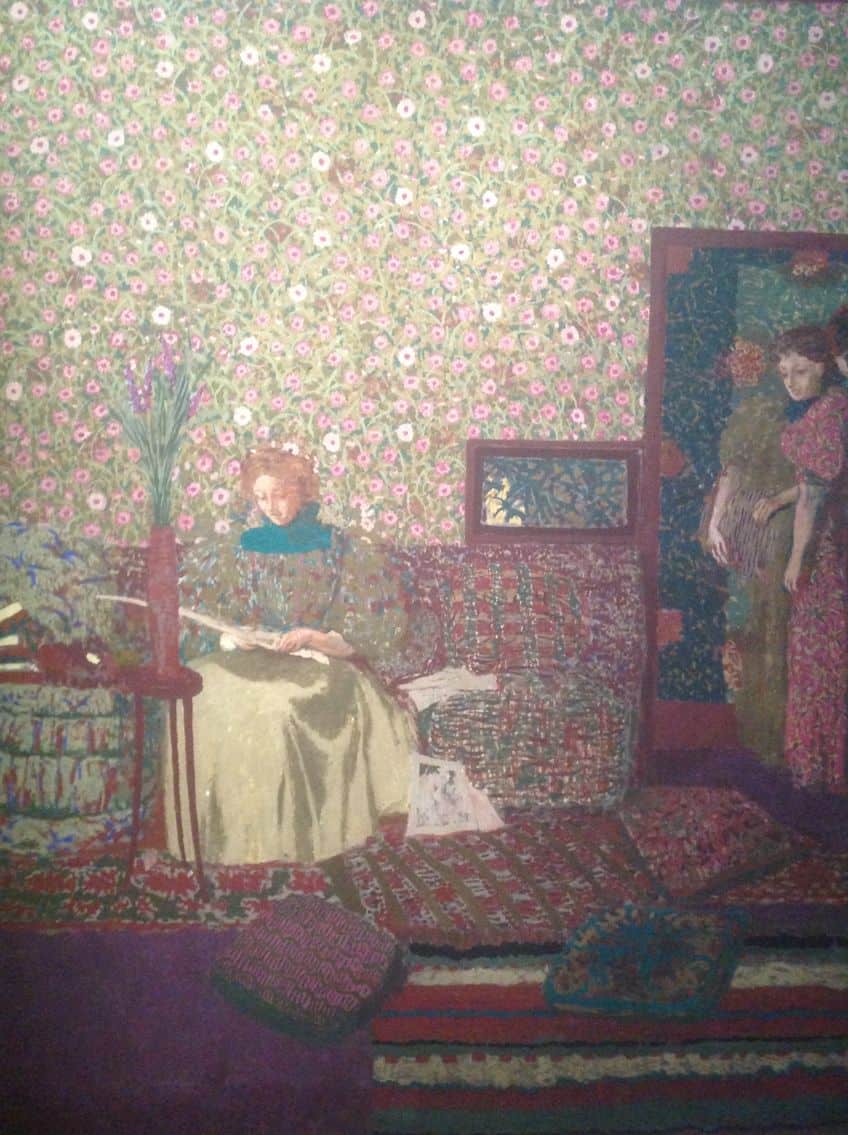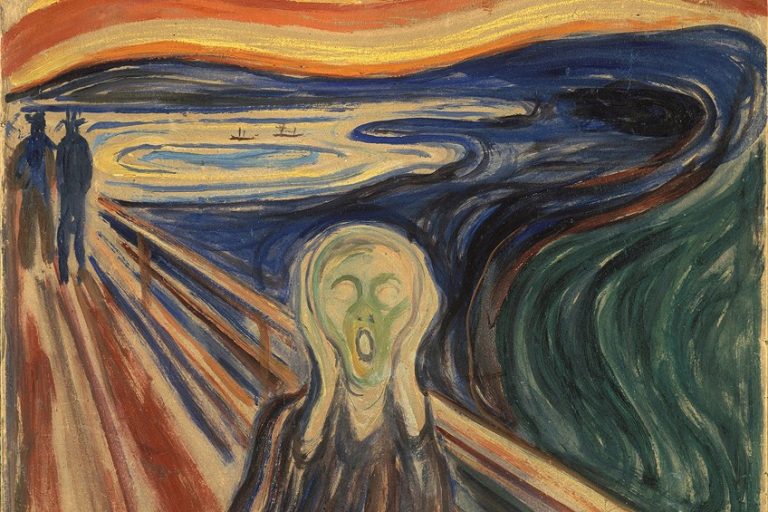“The Flowered Dress” by Édouard Vuillard – An Artwork Analysis
The Flowered Dress, painted by Édouard Vuillard in 1891, is a remarkable example of the artist’s intimate and richly textured interior scenes. A central figure in the Nabi movement, Vuillard is renowned for his ability to capture the essence of domestic life with a delicate interplay of patterns and colors. This painting features a woman in a flowered dress, surrounded by a lush, patterned environment that blurs the boundaries between figure and setting. Vuillard’s use of vibrant hues and intricate details creates a tapestry-like quality, immersing the viewer in the serene, yet dynamic world of his subject. The Flowered Dress stands as a testament to Vuillard’s unique vision and his contribution to Post-Impressionism, offering a glimpse into the private, ornamental realms that characterized much of his work.
Key Takeaways
- The Flowered Dress by Édouard Vuillard showcases his contribution to the Intimist movement and the Nabis group with its intricate patterns and domestic subject matter.
- Vuillard’s art stands out for its portrayal of intimate indoor settings, emphasizing the emotional depth and subtle complexities of everyday life.
- The Flowered Dress continues to be celebrated for its artistic innovation and its reflective portrayal of the social fabric of Vuillard’s time.
The Artist Behind The Flowered Dress
| Artist | Édouard Vuillard (1868 – 1940) |
| Date Created | 1891 |
| Medium | Oil on canvas |
| Genre | Genre painting |
| Period/Movement | Post-Impressionism, Nabi Movement |
| Dimensions (cm) | 46 x 38 |
| Series/Versions | Single version, no known series |
| Where Is It Housed? | São Paulo Museum of Art, São Paulo, Brazil |
| What It Is Worth | Estimated value varies |
In the realm of Post-Impressionist art, Édouard Vuillard holds a distinctive position with his work, The Flowered Dress, painted in 1891. Vuillard, a French artist born in 1868, was closely associated with the Nabis group, who were known for their intimate domestic scenes that often blurred the lines between the viewer’s space and that of the subject. The Flowered Dress exemplifies Vuillard’s keen ability to capture the essence of interior life—its stillness, nuances, and emotional undercurrents—through his unique use of pattern and color.

Set against a backdrop of Vuillard’s signature rich, textural composition, The Flowered Dress features a figure enveloped in a patterned garment, creating a harmonious blend of the sitter with her surroundings. The painting embodies Vuillard’s mastery of Intimist scenes—a style characterized by its focus on the interior spaces and the quiet, contemplative moments of daily life.
As Vuillard’s oeuvre traversed the societal changes of the late 19th and early 20th centuries, his works, including The Flowered Dress, have come to be revered not only for their aesthetic appeal but also for their insightful commentary on the era’s domestic sphere.
Les Nabis Movement
Les Nabis, a group born out of the eagerness for artistic innovation in 1890s Paris, included Vuillard among its foremost members. Pivotal figures such as Maurice Denis and Pierre Bonnard stood alongside Vuillard, embracing a philosophy that art should reflect an artist’s personal vision. The movement was characterized by:
- A departure from realism
- Flat areas of bold color
- Enigmatic symbols and personal iconography
Édouard Vuillard contributed to Les Nabis by incorporating these elements into intimate domestic scenes, often blurring the lines between the distinct space of a room and the patterns of textiles and wallpapers.

Influence and Collaborations
Vuillard’s work cannot be viewed in isolation from his relationships with his contemporaries. Collaborative efforts, especially within Les Nabis, played a significant role in his development as an artist. Notable collaborations included:
- Maurice Denis, renowned for his theoretical writings on painting, shared a particular influence on Vuillard’s use of color and composition.
- Pierre Bonnard, another Nabi member, worked closely with Vuillard; their work often displayed similar thematic undertones and stylistic preferences.
These partnerships, united by a shared aesthetic ideology, were instrumental in the evolution of Vuillard’s signature style, which went on to inform works like The Flowered Dress.
The symbiosis of their shared and individual contributions to the art world solidified their legacies within the annals of post-impressionism and beyond.
Contextual Significance
The Flowered Dress by Édouard Vuillard stands as a testament to the artist’s fascination with intimate domesticity and the influence of artistic movements during his time. Édouard Vuillard was known for capturing the essence of interior scenes with a delicate intimacy. In The Flowered Dress, the representation of domestic life is both profound and nuanced. The interior space, often a recurring subject in his work, is detailed with a rich pattern in both attire and furnishings, illustrating Vuillard’s meticulous attention to textures and colors that breathe life into everyday moments.

The domestic scene often becomes a canvas for Vuillard, where the subtleties of daily life are emblemized by the presence of figures adorned in patterned garments, set against similarly intricate backdrops. This layering of patterns was more than decorative; it was a way to express the character of the domestic interior, a space that Vuillard saw as deeply personal and evocative.
The Broader Artistic Context
Positioned within the Post-Impressionist movement, Vuillard contributed to the broader artistic context by being a founding member of Les Nabis, a group influential in transitioning from impressionism to abstract art. The Flowered Dress embodies some of the artistic ideals of this group, including the flat planes of color and intimate depiction of private spaces. Vuillard’s work does not typically involve expansive settings such as parks, but rather the intimate environments of homes and personal spaces.
Nonetheless, his compositions often feel like exterior scenes transposed within the bounds of domestic walls, rich with emotional resonance and indicative of a broader artistic dialogue about what constitutes art in the burgeoning modern world.
Detailed Analysis of The Flowered Dress
The Flowered Dress is a painting that exemplifies Edouard Vuillard’s meticulous attention to composition and patterns, rendered with a vivid yet harmonious color palette.

Composition and Subject Matter
The painting presents a genre scene that captures an intimate domestic environment. Vuillard, utilizing oil on canvas, crafts a visually cohesive narrative through his efficient placement of figures and objects. The flowered dress, the painting’s namesake, isn’t merely an article of clothing but serves as a focal point around which the other elements of the portrait are arranged.
Figures within the painting appear enmeshed with their surroundings, emphasizing the lack of distinction between characters and their environment which is a characteristic approach of Vuillard’s work.

Use of Patterns and Colors
Vuillard’s use of patterns is both strategic and symbolic. The composition is riddled with intricate patterns that dance across the surfaces of the depicted scene. These patterns, especially visible on the titular flowered dress, are not just decorations but create a sense of depth and texture. The colors in the painting are deliberately chosen, often embodying earthy, muted tones that evoke a sense of warmth. The oil on canvas technique allows for a rich application of these colors, imbuing the painting with a subtle vibrancy that belies its initial understated appearance.
Vuillard’s mastery in the use of colors enhances the intimate atmosphere that the painting is known for.

The Painting’s Journey and Legacy
The Flowered Dress by Édouard Vuillard has undergone a significant journey since its creation in 1891, becoming a celebrated piece in the world of art for its style and historical value.

Ownership and Exhibitions
Originally created by Édouard Vuillard, a member of the post-impressionist avant-garde group Les Nabis, The Flowered Dress has been a part of various prestigious collections over time. It was acquired by the Museu de Arte de São Paulo Assis Chateaubriand (MASP) in 1958, where it remains as a vital exhibit. Exhibitions of Vuillard’s work, including The Flowered Dress, have taken place at significant museums worldwide.
The National Gallery of Art in Washington is known to have hosted Vuillard’s artworks, potentially increasing public access to his genre paintings.
Public Reception and Critical Acclaim
The Flowered Dress is now in the public domain, allowing for its image to be widely disseminated, which has played a role in its reception. Critics have often praised Vuillard for his intimate portrayal of domestic life, and this painting is no exception. It features Vuillard’s characteristic flatness of form and a keen sense for pattern and color, likely influenced by his mother, a seamstress.

The art community and general public have shown deep appreciation for Vuillard’s work, especially genre paintings like The Flowered Dress, for capturing the essence of domesticity with emotional depth and technical prowess. The painting continues to resonate with audiences and maintains a prominent legacy within art history.
The Flowered Dress by Édouard Vuillard epitomizes the artist’s mastery in weaving together the everyday and the extraordinary through his distinct use of pattern and color. This painting, with its intricate details and harmonious composition, not only reflects Vuillard’s intimate connection to his subjects but also his innovative approach within the Nabi movement. The delicate interplay of the flowered dress with its surroundings encapsulates a moment of serene domesticity, transforming the mundane into a rich visual experience. As a testament to Vuillard’s legacy, The Flowered Dress continues to captivate audiences, offering a profound appreciation for the beauty and complexity found in the quiet corners of everyday life.
Frequently Asked Questions
What Is the Significance of The Flowered Dress in Édouard Vuillard’s Body of Work?
The Flowered Dress is notable for encapsulating the essence of Vuillard’s intimacy in domestic settings. It embodies his attention to interior spaces and the complex patterns that characterize his work.
In Which Artistic Period Is The Flowered Dress by Vuillard Categorized?
Vuillard painted The Flowered Dress in 1891, a period linked with Japonism and the burgeoning Post-Impressionist movement, specifically within a subset known as Intimism.
What Techniques Did Édouard Vuillard Employ in The Flowered Dress?
In The Flowered Dress, Vuillard utilized a synthesis of pattern and color, reflecting his innovative approach to genre painting. His technique often involved muted palettes and a focus on textural details which became a hallmark of his oeuvre.
How Does The Flowered Dress Reflect Vuillard’s Style Compared to His Other Paintings?
The Flowered Dress reflects Vuillard’s seamless integration of figures and their surroundings, a distinguishing feature of his style. Further exemplifying Intimism, this painting, like his other works, suggests a private, hushed atmosphere through the depiction of everyday interiors.
Isabella studied at the University of Cape Town in South Africa and graduated with a Bachelor of Arts majoring in English Literature & Language and Psychology. Throughout her undergraduate years, she took Art History as an additional subject and absolutely loved it. Building on from her art history knowledge that began in high school, art has always been a particular area of fascination for her. From learning about artworks previously unknown to her, or sharpening her existing understanding of specific works, the ability to continue learning within this interesting sphere excites her greatly.
Her focal points of interest in art history encompass profiling specific artists and art movements, as it is these areas where she is able to really dig deep into the rich narrative of the art world. Additionally, she particularly enjoys exploring the different artistic styles of the 20th century, as well as the important impact that female artists have had on the development of art history.
Learn more about Isabella Meyer and the Art in Context Team.
Cite this Article
Isabella, Meyer, ““The Flowered Dress” by Édouard Vuillard – An Artwork Analysis.” Art in Context. September 24, 2024. URL: https://artincontext.org/the-flowered-dress-by-edouard-vuillard/
Meyer, I. (2024, 24 September). “The Flowered Dress” by Édouard Vuillard – An Artwork Analysis. Art in Context. https://artincontext.org/the-flowered-dress-by-edouard-vuillard/
Meyer, Isabella. ““The Flowered Dress” by Édouard Vuillard – An Artwork Analysis.” Art in Context, September 24, 2024. https://artincontext.org/the-flowered-dress-by-edouard-vuillard/.











